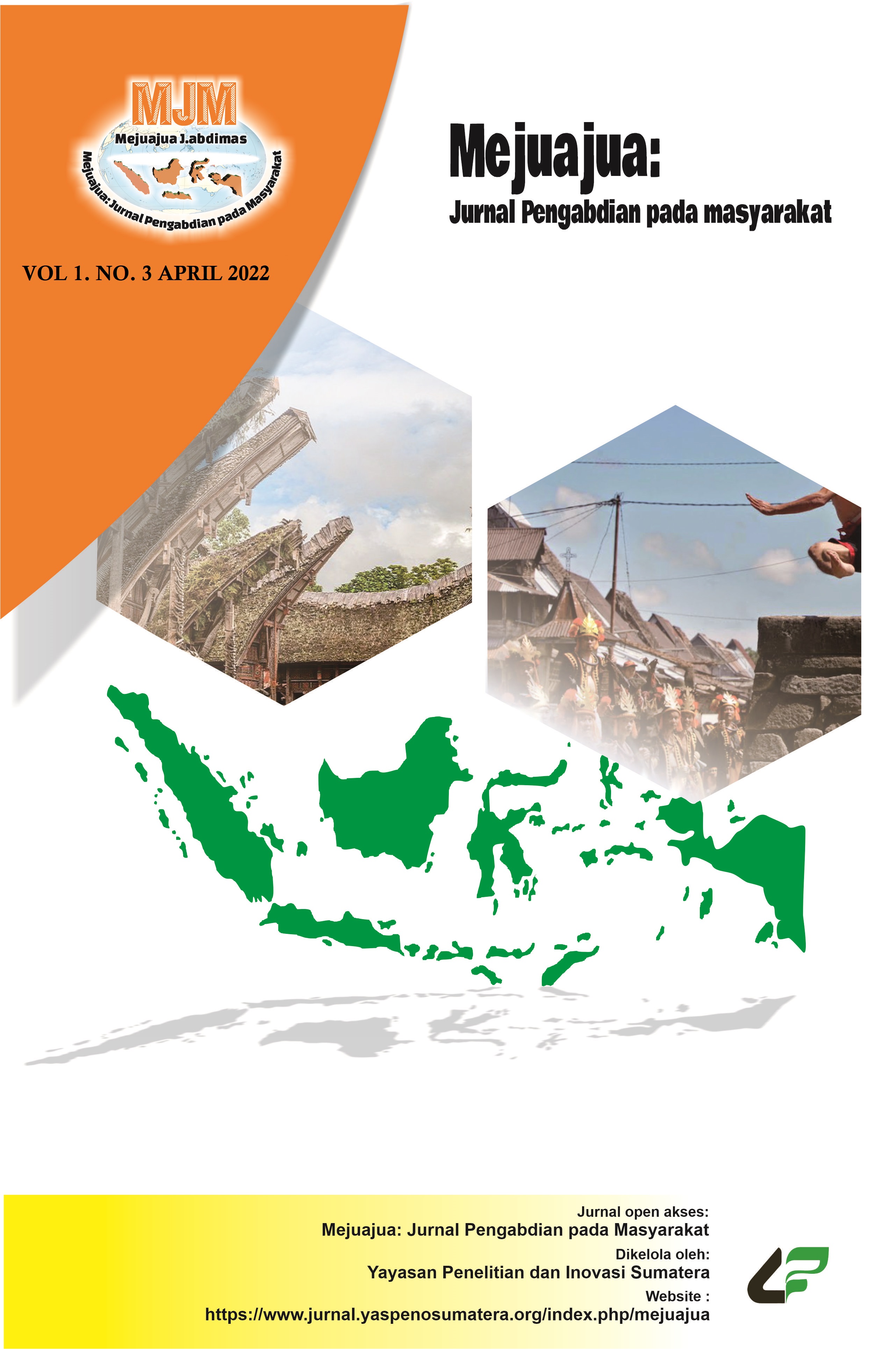Implementasi Pembukuan Sederhana Dalam Upaya Peningkatan Produktivitas Kain Songket Tenun Medan
DOI:
https://doi.org/10.52622/mejuajuajabdimas.v1i3.39Keywords:
Sewing Machine; Simple Bookkeeping; increased sales turnoverAbstract
The impact of the COVID-19 pandemic has caused several Micro, Small and Medium Enterprises to decrease their production due to decreased demand from customers, one of which is our Service partner. Through this service, we hope that we can help our partners in overcoming production problems as well as in terms of bookkeeping. In this service activity the Service team has visited the Service partner to gather information regarding the main needs in the production process to sales, and the result is that the Service team donated equipment in the form of a high-speed sewing machine as much as 1 (one) unit to partners, the sewing machine can be used in production activities, previously in production our partners used the manual method, so with the help of this machine it is possible to increase the production capacity of partners. The method used in this service activity is a visit, on the first visit the Service team explores information related to business development and the obstacles or problems faced so far, then the Service team carries out service activities that answer the problems or constraints described by partners, the distribution of grants in the form of 1 unit of high speed sewing machine and assistance in simple bookkeeping procedures is a solution to the problems or obstacles experienced by partners so far. The Devotion Team hopes that partners will be better in running Micro, Small and Medium Enterprises. The real evidence from the work of 1 unit of high speed machine is the increase in production capacity to double before only being able to produce 10 units of production per day after the addition of a high speed sewing machine, production to 20 units per day and what's interesting is that our partners have implemented simple bookkeeping adequate and appropriate
References
Haryanti, Dewi. 2018. Potret UMKM Indonesia , Si Kecil yang Berperan Besar, Jurnal UMKM Indonesia
Jauhari, Jaidan. 2010. Upaya Pengembangan usaha kecil dan menengah (UKM) dengan memanfaatkan e-commerce, jurnal Sistem informasi (JSI) vol. 2, no.1
Jurnal, bulletin, dan majalah ilmiah (periodical). Format: Peneliti 1., Peneliti 2., dan Peneliti 3. (Tahun). Judul Artikel. Nama Jurnal, Volume(Edisi), Halaman.
Harahap, Baginda., Rambe, Aripin., & dkk. 2022. Penerapan Komputer Dasar Terhadap Juru Kasir & Juru Buku Pada Koperasi Simpan Pinjam. Jurnal Altifani, Penelitian dan Pengabdian kepada Masyarakat. Vol. 2, Januari 2022, Hal. 75-84.
Arikunto, Suharsimi. 2002. Prosedur Penelitian Suatu Pendekatan Praktek, PT. Rineka Cipta, Jakarta: Andriani, Soemantri. 2003. Tanggung Renteng Setia Budi Wanita, Semarang: Limpad.
Hadiyati, Ernani. 2009. Kajian Pendekatan Pemasaran Kewirausahaan dan Kinerja Penjualan Usaha Kecil. Jurnal Manajemen dan Kewirausahaan, Vol. 11 (2): 183-192.
Hub usa. 2009. Prospek Usaha Kecil dalam wadah Inkubator Bisnis, Ghalia Indonesia, Jakarta.
Huda, Nurul & Mohammad Heykal. 2010. Lembaga Keuangan Islam: Tinjauan Teoritis dan Praktis, Kencana, Jakarta
Panggabean, Riana. 2007. Profil Koperasi Wanita Setia Bhakti Wanita Surabaya Jawa Timur. Jurnal Infokop, Vol. 15 (1) Juli.
Pusat Bahasa. 2008. Kamus besar Bahasa Indonesia, Gramedia Pustaka Utama, Jakarta.
Ramdhansyah & Sondang Silalahi. 2013. Pengembangan Model Pendanaan UMKM Berdasarkan Persepsi UMKM. Jurnal Keuangan dan Bisnis, Vol.5 (1): 30-40.
Hadi, S. (2000). Metodologi Penelitian. Yogyakarta: Andi Pustaka Offset. Harahap, A.K. (2011). Penerapan Tambahan Penghasilan Pegawai Dalam Meningkatkan Kinerja Dan Disiplin Pegawai Pada Badan Kepegawaian Daerah Provinsi Sumatera Utara. TesisTidak Dipublikasikan Fakultas Ilmu Sosial Universitas Sumatera Utara.
Hasibuan, M. (2004). Manajemen Sumber Daya Manusia. Jakarta: Bumi Aksara.
Hunjra, A. I., Raza, H., & Munir, I. U. (2014). The Role of Employee Retention and Employee Productivity on the Performance of Oil & Gas Sector of Pakistan. International Journal of Economics and Empirical Research, 2(11), 449-453.
Jannatin, M., & Hadi, C. (2012). Pengaruh Kualitas Kehidupan Kerja (Quality of Work Life). Jurnal Psikologi Industri dan Organisasi, 1(02), 144-148.
Kaho, Y.R. (2001). Pengukuran Disiplin Kerja. Jurnal Ilmu Manajemen Sumber Daya Manusia, 19(2), 116-138.
Kartono, K. (2002). Psikologi Sosial Untuk Manajemen, Perusahaan, & Industri. Jakarta: PT.Raja Grafindo Persada.
Leblebici, D. (2012). Impact Of Workplace Quality On Employee’s Productivity: Case Study Of A Bank In Turkey. Journal of Business, Economics & Finance, 1 (1), 38-49.
Nawawi, H. (2003). Kepemimpinan Mengefektifkan Organisasi. Yogyakarta: Gadjah Mada University Press.
Naqvi, S. M., Khan, M. A., Kant, A. Q., & Khan, S. N. (2013). Job Stress and Employees’ Productivity: Case of Azad Kashmir Public Health Sector. Interdisciplinary Journal Of Contemporary Research In Business, 5(3), 525-542.
Nitisemito, A. (1996). Manajemen Personalia (Manajemen Sumber Daya Manusia). Jakarta: Ghalia Indonesia. Rahmawati, D. (2013). Pengaruh Motivasi Terhadap Produktivitas Kerja Karyawan PR Fajar Berlian Tulungagung. Jurnal Universitas Tulungagung BONOROWO, 1(1), 1-16.
Downloads
Published
How to Cite
Issue
Section
License
Copyright (c) 2022 Raya Puspita Sari Hasibuan, Anggiat Situngkir, Darmawati Simanjuntak

This work is licensed under a Creative Commons Attribution-ShareAlike 4.0 International License.
Mejuajua: Jurnal Pengabdian pada Masyarakat provides open access to anyone so that the information and findings in these articles are useful for everyone. This journal's article content can be accessed and downloaded for free, free of charge, following the creative commons license used.

Mejuajua: Jurnal Pengabdian pada Masyarakat is licensed under a Creative Commons Attribution-ShareAlike 4.0 International License.







